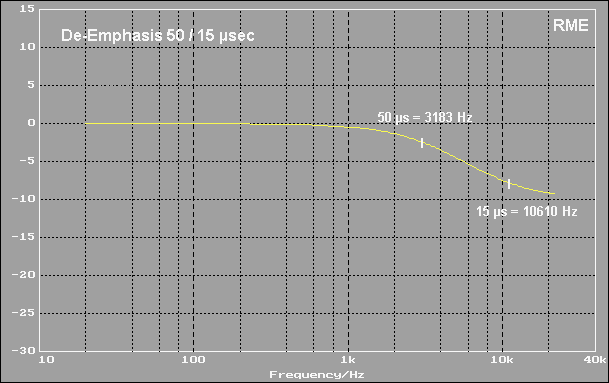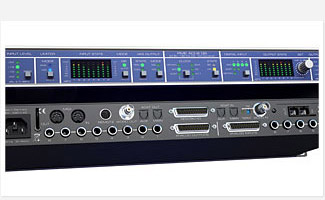TMS: Track Marker Support
CD Track / DAT Start ID Transfer and Emphasis Recognition
*Note: TMS is not supported by the RME DIGI32 series, DIGI9652, or DIGI9636
RME sound cards offer several worldwide unique features, among them the ability to transfer all Channel Status bits to the recording software. These additional data offer a host of useful functions, demonstrated by DIGICheck®, our (worldwide unique...) utility for test, measurement and analysis of the digital data stream. Of highest interest is the possibility to gain useful information out of the so called user bits. This task is performed by TMS, the Track Marker Support of the RME sound card line. TMS allows every recording software, no matter which platform, for example to detect CD track numbers and DAT start-IDs while recording, and to set a marker at the right place.
This TECH INFO describes the principle of transferring the additional data. All RME cards support TMS with the exception of the DIGI32 series, the DIGI9652, and the DIGI9636. Cards of other manufacturer's having a DSP on board are in general enabled to also implement TMS. Therefore we expect this method to show up in other cards too, especially as we don't ask for any license fees. We only ask for a copyright notice in the corresponding product to clearly state that TMS is a technology from RME.
Technical background: the 32 bit technology
As far as we know, RME sound cards are the first and only audio cards to allow recording of the complete 32 bit digital audio data stream. Besides the usual 24 audio bits P, C, U and V bits are also transmitted. That's 28? Right, the first 4 bits form the preamble. This synchronization signal isn't needed anymore after a successful receiving and decoding of the signal. To use the data of the PCUV-bits the start of the block must be known. Therefore the data stream sent from the sound card to the record program also includes the CBL (channel block start) signal.
The transmission of the additional bits is active only in 4 byte per sample format (24 bit/32 bit.)
RME sound cards transmit the data in the following format to the recording program:

X = Audio data 0 = unused B = CBL P = Parity C = Channel Status U = User Bit V = Validity Bit
The decoding of the additional data must be done with regard to a constant delay. The CUVP-bits are extracted directly out of the data stream, but the CBL information is taken from the corresponding pin of the CS8414. Because of this the CBL information is delayed by two samples. The CBL does not indicate the first, but the third sample. The software decoding the data has to compensate this delay.
Advantages of this method
This method has several advantages. Modern cards nearly exclusively use the Crystal Receiver CS8412/8414, which make all the above signals available (only the delay of 2 samples has to be added in case all signals are taken directly from the chip.) The 4 byte/s mode is available in nearly every professional recording software. A coarse detection of the TMS capability can be done already with this mode, as cheap soundcards don't support 4 byte mode, and sure will not do so in the near future.
As the decoding of the user bits (for TMS) is done through the recording software TMS can be used without limits. A direct decoding in the card's hardware wouldn't be possible in many cases, and is much more complicated as a software solution which uses the computer's CPU. The CPU overhead caused by decoding is so small it doesn't matter, especially as TMS will only be used with 2-track recordings.
But the most important argument is that the transfer of the additional data is done in a 'normal' format. Neither software nor hardware manufacturer's are forced to implement a new and/or incompatible way of data transfer into their products.
Disadvantages of this method
As mentioned the decoding of the user bits for a detection of CD-track or DAT start-ID is done in the corresponding record program. The main reason such a method as TMS wasn't introduced earlier is probably that most programmers and engineers don't know how to retrieve the useful information out of the data stream. To prevent TMS from being born dead RME provides a free source code to all software companies, including the routines demonstrated in DIGICheck. Based on this exemplary code an implementation is no problem anymore and done in less than a day.
The additional bits can be measured as noise when performing a 32 bit record - at around -164 dBFS. But for such a measurement you need a special 32 bit analyzing software, which calculates data internally with at least 64 bit. In recording practice normally all status bits disappear - most currently available software uses not more than 24 bit internal resolution, which allows to record signals down to -144 dBFS. All signals lower will turn to digital zero. In general we recommend (and that's the way it has been done so far) in TMS mode to write only 16 or 24 bit files to disk, and to delete all additional bits after decoding.
TMS in practice
For a successful integration of TMS into a recording software, and for achieving an efficient and highly usable interface, some basic ideas and methods should be taken into account.
- TMS Activation
To activate TMS an additional check button (or menu entry) is required, which should be named 'TMS' or 'Track Marker Support'. This button activates the automatic marker generation. It should also activate the 4 byte/s mode (there is no need to inform the user of this mode.) - Bit Resolution
It is to be noted that the user should be able to choose between a recording in 16 bit or 24 bit resolution. Although all CD-players and nearly all DATs are limited to 16 bit the first 24 bit DATs already entered the market. Because of this 24 bit recording should be possible. -
TMS Capability
Checking the TMS capability of the used digital card and the attached device is a basic assumption for a successful usage. The first step is to open the wave device in 4 byte/s mode. If this fails the used card is clearly identified as not capable of TMS. In this case an error message should be shown, presenting the following statement: 'The currently used record device offers no Track Marker Support'.
In case the 4 byte/s mode was successfully activated the next step is to check whether user bits can be received. There should be a check whether the record device supports TMS at all, AND a check whether a DAT or CD-Player is attached to the cards input. This check is part of the source code supplied by RME. In case no DAT or CD can be detected an error message should be shown, presenting the following statement: 'The currently used record device either offers no Track Marker Support or no CD-Player/DAT is used as signal source'.
With these two error messages TMS can be used without any problems, errors or malfunctions are explained and presented to the user in an easy to understand way.
-
Decode Errors
The second generation source code supplied by RME includes special routines to avoid errors (CD read errors, DAT drop outs, set valid bit, so a stable and secure operation is guaranteed.
Emphasis
Due to the fact that we constantly get requests from our customers about an Emphasis detection during recording RME now also offers an Emphasis detection, included the TMS source code. After a signaling of this bit the recording software in principle has two choices:
- Storing the Emphasis information in an internal data base, inside the file and/or display of a warning message to the user.
- Activation of a digital (De-Emphasis) filter within the program, which corrects the frequency response nearly loss- and error-free in real-time during recording.

Method 1 suffers from a big disadvantage: At playback normally no automatic control is possible, so the user has to manually set the Emphasis bit in the settings dialog of the RME card. Additional the recorded wave file can't be marked clearly as 'pre-Emphasis', which might cause a later processing without de-Emphasis. Method 2 removes all problems that might occur with pre-Emphasis material, as after the recording the audio material is no longer emphasized, but turned into 'normal' material that no longer needs any special treatment.
Summary
TMS is an easy to use technology for direct transfer of CD track number and DAT start-IDs, and the detection of emphasized audio material. Functions strongly demanded (not only) by professionals.
TMS is already implemented in Samplitude from SEK'D (since version 5.21) and WaveLab from Steinberg (since version 3.0). We are in contact with other software manufacturer's so that this useful functionality will be available to all users.
Copyright © Matthias Carstens.
All entries in this Tech Infopaper have been thoroughly checked, however no guarantee for correctness can be given. RME cannot be held responsible for any misleading or incorrect information provided throughout this document. Lending or copying any part or the complete document or its contents is only possible with the written permission from RME.

